The Congo Nile Trail pales in comparison to gorilla tourism in Rwanda. Gorilla Tours are so popular that visitors only think about conquering the Congo Nile dive as optional. The government of Rwanda must be praised for the great efforts put in ensuring diversity in her tourism attractions. One of the recent developments was the launching of the Congo Nile Trail in 2011 – an attempt at making Rwanda a top biking destination in Africa.
The Congo Nile Trail refers to a 227km trail passing through Lake Kivu starting from the northern shores in Gisenyi and ending in the Southern shores of Rusizi District. The trail doesn’t pass through Congo or anywhere near the river Nile per se but is named after a landmark/watershed that separates the Congo and Nile rivers. The Congo Nile Trail is arguably the best biking trail in East Africa. It is the 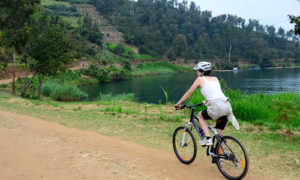 best way to experience Rwanda’s natural beauty and the clean air. The trail passes through stunningly beautiful scenery including Nyungwe Forest National Park, Rwanda’s famous rolling hills, the clear waters/ beaches of Lake Kivu and glimpses of the distant DR Congo. Besides the scenery, you get to see how the locals go about their daily business in their coffee, banana and tea plantations. You also pass through small towns, shops, valleys, waterfalls, small local markets and fishing villages with warm greetings from smiling children and curious elders. You might even stop by the Mugonero orphanage and be entertained to local Rwandan dances. The Kiziba refugee settlement holding about 17, 000 Congolese refugees is also located near the trail. The climax of it all is going up to the very top of the Congo Nile.
best way to experience Rwanda’s natural beauty and the clean air. The trail passes through stunningly beautiful scenery including Nyungwe Forest National Park, Rwanda’s famous rolling hills, the clear waters/ beaches of Lake Kivu and glimpses of the distant DR Congo. Besides the scenery, you get to see how the locals go about their daily business in their coffee, banana and tea plantations. You also pass through small towns, shops, valleys, waterfalls, small local markets and fishing villages with warm greetings from smiling children and curious elders. You might even stop by the Mugonero orphanage and be entertained to local Rwandan dances. The Kiziba refugee settlement holding about 17, 000 Congolese refugees is also located near the trail. The climax of it all is going up to the very top of the Congo Nile.
Travelers have four options of completing the trail – by car, motorcycle, bike and walking. Each method has its own advantages. Walking and biking may be tiring but are the best ways of completing the trail. The two methods allow travelers appreciate the beautiful scenery along the trial and connect more with the locals. They are good forms of exercise and can allow one easily be joined by other travelers unlike driving or motorcycling. Walking through the Congo Nile Trail can be completed in 10 days, while biking takes 5 days. If time doesn’t allow, travelers could complete the trail in sections at a time. Take note of the rainy seasons (March – May and October – November). Heavy rains make some sections of the trail muddy and difficult to maneuver through.
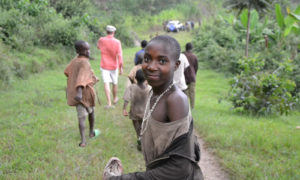 Regardless of which method you choose to complete the trail, there are free maps to guide you that are available to visitors at the Rwanda Development Board offices in Kigali, Musanze and Gisenyi. Maps help point out directions, correct distances, interesting places, landmarks, route changes and time taken passing through specific sections of the trail. A lone traveler living in Rwanda only needs a map, self assurance and personal supplies. More high-end visitors living in Rwanda can hire their own guides, porters and cooks to accompany them throughout the journey. If you are coming as a visitor to Rwanda, then the best thing to do is use the services of a tour operator to organize everything on the ground before you arrive. A tour company can help arrange for porters, guides and other necessities while taking into consideration your interests, time and budget. Mission Africa Safaris can help you acquire the right maps, hire/buy suitable mountain bikes and related spare parts. We have experience arranging for guides, cooks, porters and transportation to and from the starting and ending points.
Regardless of which method you choose to complete the trail, there are free maps to guide you that are available to visitors at the Rwanda Development Board offices in Kigali, Musanze and Gisenyi. Maps help point out directions, correct distances, interesting places, landmarks, route changes and time taken passing through specific sections of the trail. A lone traveler living in Rwanda only needs a map, self assurance and personal supplies. More high-end visitors living in Rwanda can hire their own guides, porters and cooks to accompany them throughout the journey. If you are coming as a visitor to Rwanda, then the best thing to do is use the services of a tour operator to organize everything on the ground before you arrive. A tour company can help arrange for porters, guides and other necessities while taking into consideration your interests, time and budget. Mission Africa Safaris can help you acquire the right maps, hire/buy suitable mountain bikes and related spare parts. We have experience arranging for guides, cooks, porters and transportation to and from the starting and ending points.
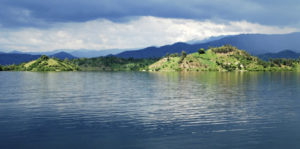 N.B: The Congo Nile trail passes through sections with different characteristics. There are rocky areas, dusty roads and hilly areas. Most sections of the trail are not flat for long. There is nothing like a single biking or walking track. You will often be climbing and slopping while sharing the road with others before reentering narrower trails. Travelers need to be careful while on the roads and should watch out for cars, motorcycles and local pedestrians.
N.B: The Congo Nile trail passes through sections with different characteristics. There are rocky areas, dusty roads and hilly areas. Most sections of the trail are not flat for long. There is nothing like a single biking or walking track. You will often be climbing and slopping while sharing the road with others before reentering narrower trails. Travelers need to be careful while on the roads and should watch out for cars, motorcycles and local pedestrians.
Hiking the Congo Nile trail
How to get to the starting point
While on a Rwanda road trip, the journey from Kigali to Gisenyi takes about 3 hours by bus. If you are traveling with your own bike, then you will need to negotiate with the bus conductor to reserve extra space/sits for you and the bike. Alternatively, a tour operator can arrange a tour van to take you up to the starting point in Gisenyi and then pick you up later once you have completed the trail. The journey back to Kigali from the finishing point takes much longer. If you stopped in Kamembe, then your journey back to Kigali will take about 5 hours.
Renting and Purchasing a Bike
It is costly moving with your own bike as an international traveler. You might need to purchase or hire a proper mountain bike from specialized outlets either Kigali or once you reach Gisenyi. In Gisenyi, Inzu Lodges may help with renting bikes on request. Ensure that you test the bike yourself to ensure that it is in good mechanical condition and that you are comfortable with it. The bike should also come with important spare parts and a pump.
Level of difficulty of Congo Nile Divide Trail
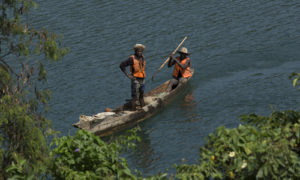 You need to be reasonably fit and accustomed to mountain biking to complete the trail by walking or biking. If you doubt your overall fitness, then there is an option of completing the trail in sections as you take breaks to take part in refreshing and fun activities such as relaxing and taking boat rides or canoes along Lake Kivu, swimming or checking out the waterfalls.
You need to be reasonably fit and accustomed to mountain biking to complete the trail by walking or biking. If you doubt your overall fitness, then there is an option of completing the trail in sections as you take breaks to take part in refreshing and fun activities such as relaxing and taking boat rides or canoes along Lake Kivu, swimming or checking out the waterfalls.
Getting Water and Food
The Congo Nile trail was planned to pass through major villages, shops, trading centers and local markets. Water, fruits and food is can easily be purchased along the trail. You need is to learn how to recognize local signs leading to shops and other outlets. This is a good time to try out some of the local Rwandan dishes.
Accommodation along the Congo Nile Trail
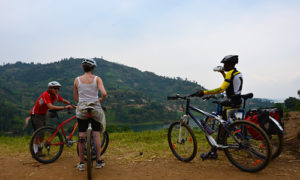 Finding accommodation along the trail is easy although some travelers prefer to set their own campsites using tents near a village, school, orphanage or plantation as soon as it starts getting dark. For those who don’t travel with the right gear, the Rwanda Development Board or your tour operator can arrange to hire tents or connect you to the right outlets or suppliers. The Rwanda Development Board has built several campsites along the trail that can easily be traced using signposts along the trail. These campsites already have tents so you only need to move with light bedding and other important gear. Budget travelers can choose from any of the following accommodation options along the trail.
Finding accommodation along the trail is easy although some travelers prefer to set their own campsites using tents near a village, school, orphanage or plantation as soon as it starts getting dark. For those who don’t travel with the right gear, the Rwanda Development Board or your tour operator can arrange to hire tents or connect you to the right outlets or suppliers. The Rwanda Development Board has built several campsites along the trail that can easily be traced using signposts along the trail. These campsites already have tents so you only need to move with light bedding and other important gear. Budget travelers can choose from any of the following accommodation options along the trail.
- Home Saint Jean in Kibuye: Is quiet popular with budget travelers and is located behind a roadside church. You can walk down a steep slope to the Lake Kivu.
- Inzu Lodge in Gisenyi: Located strategically with a stunning view of Lake Kivu. They offer good food, free WiFi, gift shops and tents to travelers. Travelers can request the hotel to organize traditional dance performances from local dance troupes.
- Peace Guesthouse in Kamembe: Offers tranquil settings, beautiful gardens and a good restaurant along the Lake Kivu.
- Kinunu Guesthouse: They offer great eco-tourism experience with a magnificent view of the Lake Kivu.
- Bethanie Guesthouse in Kibuye: Simple rooms that offer great relaxation as one looks right into Lake Kivu. You might even decide to go for a boat ride to one of the numerous islands.
- L’Esparance Guesthouse in Mugonero: is another popular place and requires travelers to make a $10 donation for a night with meals included.
- Kibogora Guesthouse in Kibogora.
Luxury travelers can choose from any of these more high-end hotels and lodges.
- Paradis Malahide in Gisenyi: A luxury resort built to near perfection with fine material and great gardens along the Lake Kivu – perfect for relaxation.
- Lake Kivu Serena Hotel: Is a luxurious 4 star hotel built to the highest standards with an outdoor swimming pool, bar, restaurant and stunning scenery.
- Cormoran Lodge: Is a new luxury lodge on the shores of Lake Kivu with views of the Nyiragongo volcano in Congo. The lodge is built with wood and offers great views of the Lake Kivu and the nearby islands.
- Moriah Hill Hotel: Each room has a large balcony offering great views of Lake Kivu. There are great restaurants and conference/meeting rooms. Visitors can go visit one of the numerous Lake Kivu islands by speed boat.
Gear for the Congo Nile Trail
In case you are planning on walking, cycling or biking through the Congo Nile trails, you should think about coming along with the following items/gear (If applicable).
- A sleeping bag/sack
- A bike pump for bikers
- An extra bike tire
- Clothing’s to change
- Warm clothing for the cold night
- A dust Mask
- Gloves
- Toiletries
- Sunglasses for the dust
- A bicycle headlamp
- Snacks and things like boiled eggs, bread, fruits and drinking water
- Biking shoes
- Helmets
- A camera
Combining cycling through the Congo Nile Trail with other activities
Besides walking and cycling through the Congo Nile trail, travelers may choose to combine a cycling tour with any of the following activities.
- Gorilla trekking and golden monkey trekking in the Volcanoes National Park
- Visiting the grave of Dian Fossey
- Game drives at the Akagera National Park
- chimpanzee tracking and Forest canopy walks at Nyungwe Forest
- Visiting one of the genocide memorial centers in Kigali
- A cultural visit to the Iby’iwacu cultural village
- Climbing mount Karisimbi or Hiking Mount Bisoke


Hi. I will be with a friend in Rwanda for the first two weeks of October. We are interested in hiking the Congo Nile Trail from Rubavu (Gisenyi) to Rusizi (Cyangugu). We would like to arrange for a guide and assistance with food, accommodation and cultural activities along the route. Would you be able to assist in this regard? If so, what services could you provide? What would be the estimated costs? Thanks in advance for your guidance. Best regards, Stephen.
Hi. We are a couple from Spain visiting Rwanda very soon. WE are budget travelers and we are now volunteering in Uganda.
What would be the price of renting bikes for the trail? We have our own tent but we would have to leave our backpacks somewhere since they are too heavy to carry. Thank you for the information.